DFI NF4 SLI-DR Expert – Can the best get better?
by Randi Sica on November 25, 2005 12:05 PM EST- Posted in
- Motherboards
DFI NF4 SLI-DR Expert: Feature Set
The SLI-DR Expert PCB is manufactured in DFI’s familiar black with UV reactive yellow color for the bulk of plastic components such as the PCI-e/PCI slots, IDE and Floppy connectors, and yellow and orange UV colors for the DIMM slots. The layout of components on this board is very good, with the IDE and Floppy connectors on the right side of the PCB, which generally works best in most cases. The trend recently has been to place floppy and/or an IDE at the bottom of the PCB, and it’s refreshing that DFI has shied away from this practice.
The original 4-pin Molex and the 4-pin P4 style connector have been replaced by an 8-pin 12V power connector placed next to the 24-pin ATX connector. During setup of the board, we came to realize that the PC Power and Cooling Turbo-Cool 510 SLI PSU on our review bench does not include this new style 12V plug, so we utilized the standard 4-pin 12V plug, which fit fine on one side of the 8-pin connector. We saw no ill effects on stability from using the 4-pin instead of an 8-pin connector. The 4-pin floppy-type connector for video remains above the 1st x16 PCI-E slot as was provided on the original SLI-DR.
The SATA 5, 6, 7 and 8 ports are controlled by the Silicon Image SIL 3114, which (to be honest) is a disappointment. With the SIL 3132 available, it would have made sense to include that SATAII controller, which would have given this board 8 SATAII channels and thus keeping this board future-proof and flexible. This omission is a hard one to figure out based on the many changes made on of this board, considering the current proliferation and wide availability of SATAII hard drives.
IEEE 1394 Firewire is controlled by the familiar VIA VT6307. Audio is provided by their Karajan 8 Channel audio card utilizing the AC97 codec, again the same setup as the previous generation. The board also boasts momentary switches for Power on and Reset like its previous version, along with the Vitesse and Marvel Gigabit Ethernet controllers.
The most obvious change is the 90 degrees counter-clockwise rotation of the CPU and memory. This layout was first seen on the DFI ATI based RDX200 CF-DR just recently introduced, and carried over to the Expert.
Compared to the original SLI-DR, the Expert includes some major changes in its design. In a conversation with OCZ Technology’s guru, Tony Leach, an expert in memory interfaces and BIOS, Tony pointed out: “The changes I know about fall mainly with memory drive strength. Engineer Oskar Wu has added even more resistors this time to allow near full drive from the memory controller. He also has routed the traces for the DIMMs over 4 layers to cut crosstalk to the bare minimum. DFI also use similar power regulation to the ATI reference boards, which I helped spec.”
The CPU power section includes the superb Nichicon capacitors to complement DFI’s overall use of high quality Japanese capacitors throughout the board. The major change here was the move to a 4-phase PWM power section as has been used on Intel based P4 boards for a number of years. 4 Phase power, through its ability to provide clean stable power, is noted for providing increased CPU, and hence, system stability. As has been the norm in DFI’s current lineup, inclusion of heat sinks on all MOSFETs is a nice touch and very effective.
Another major change in the Expert board is its x16 PCI-E slots. They have been moved farther apart, which facilitates the use of improved cooling. Graphics card coolers such as those manufactured by Arctic Cooling and others, certain types of water blocks, and phase change evaporators were very difficult or impossible to use on the original DFI as there just wasn’t enough room to use them. The additional spacing opens up the ability for end-users to use alternative cooling methods.
The other change involves the elimination of the SLI jumper system from the original SLI-DR. The original jumper system was a bit of headache to perform and is now switched from within the BIOS.
The only criticism that currently remains involves the northbridge fan, which cannot be avoided based on the board’s layout. Long graphics cards such as the NVIDIA 6800Ultra and 7800GTX can contact the fan housing.
The fan itself is a magnetic levitation design and is quiet and effective, a nice carry-over from the original SLI-DR.
This view illustrates the power section of the memory subsystem. Of note here is the addition of an Inductor and several additional capacitors, again, to provide the utmost in stability. The most apparent change is the elimination of the previous generation’s vDIMM jumper that allowed an end-user to switch the power supply provided from the 3.3V line to the 5V line. This, of course, allowed you to have at your fingertips 4V+ to apply to your RAM modules, especially modules such as BH-5, which required it to run 260 MHz+ with tight timings. The option to use 4V+ remains with this revision, but it is now simply a matter of just adjusting the memory voltage in the BIOS.
| DFI LP UT NF4 SLI-DR Expert | |
| CPU | . AMD® Athlon 64 X2 / Athlon 64 FX / Athlon 64 / Sempron . Socket 939 |
| Chipset | . NVIDIA nForce4 SLI - Supports NVIDIA SLI (Scalable Link Interface) |
| Front Bus Speeds | . 2000MT/s HyperTransport interface |
| Memory | . Four 184-pin DDR SDRAM DIMM sockets . Supports dual channel (128-bit wide) memory interface . Supports up to 4GB system memory . Supports PC2100 (DDR266), PC2700 (DDR333) and PC3200 (DDR400) DDR SDRAM DIMM |
| SLI / Single VGA Mode | . SLI mode - Use 2 SLI-ready PCI Express x16 graphics cards (identical cards) on the PCI Express x16 slots. - Each x16 slot operates at x8 bandwidth. When the graphics cards are connected via the SLI bridge, the total bandwidth of the two graphics cards is x16. . Single VGA mode - 1 PCI Express graphics card on the PCIE1 slot operates at x16 bandwidth. - The other PCI Express x16 slot (PCIE4) operates at x2 bandwidth. |
| BIOS | . Award BIOS . CMOS Reloaded . CPU/DRAM overclocking . CPU/DRAM/Chipset over-voltage . 4Mbit flash memory |
| Power Management | . Supports ACPI STR (Suspend to RAM) function . Wake-On-Events include: - Wake-On-PS/2 Keyboard/Mouse - Wake-On-USB Keyboard/Mouse - Wake-On-LAN - RTC timer to power-on the system . AC power failure recovery |
| Hardware Monitor | . Monitors CPU/system/chipset temperature . Monitors12V/5V/3.3V/Vcore/Vbat/5Vsb/Vchipset/Vdram voltages . Monitors the speed of the CPU fan, Fan 2 and Fan 3 - fan CPU Overheat Protection function monitors CPU temperature during system boot-up |
| FSB Frequency | 200Mhz-550Mhz in 1 Mhz increments |
| LDT Multiplier | Auto, 1X to 5X |
| USB 2.0 | . 6 USB 2.0/1.1 ports |
| Expansion Slots | . 2 PCI Express x16 slots . 1 PCI Express x1 slot . 1 PCI Express x4 slot . 3 PCI slots |
| Onboard SATA II/RAID | . Four Serial ATA ports supported by the nForce4 SLI chip - SATA speed up to 3Gb/s - RAID 0, RAID 1, RAID 0+1 and JBOD - NVIDIA RAID allows RAID arrays spanning across Serial ATA and Parallel ATA . Four Serial ATA ports supported by the Silicon Image Sil 3114 chip - SATA speed up to 1.5Gb/s - RAID 0, RAID 1, RAID 0+1 and RAID 5 |
| Onboard IDE | . Supports two IDE connectors that allows connecting up to four Ultra DMA 133Mbps hard drives . NVIDIA RAID allows RAID arrays spanning across Serial ATA and Parallel ATA . RAID 0, RAID 1, RAID 0+1 and JBOD |
| IEEE 1394 | . VIA VT6307 . Supports two 100/200/400 Mb/sec ports |
| Onboard LAN | . Dual Gigabit LAN - Vitesse VSC8201 Gigabit PHY and Marvell 88E8001 Gigabit PCI . Fully compliant to IEEE 802.3 (10BASE-T), 802.3u (100BASE-TX) and 802.3ab (1000BASE-T) standards |
| Onboard Audio | . Karajan audio module - Realtek ALC850 8-channel AC'97 audio CODEC - 6 audio jacks - 1 CD-in connector - 1 front audio connector . True stereo line level outputs . S/PDIF-in/out interface |
| BIOS Revision | Award (11/2/2005) Shipping Bios |
The SLI-DR Expert PCB is manufactured in DFI’s familiar black with UV reactive yellow color for the bulk of plastic components such as the PCI-e/PCI slots, IDE and Floppy connectors, and yellow and orange UV colors for the DIMM slots. The layout of components on this board is very good, with the IDE and Floppy connectors on the right side of the PCB, which generally works best in most cases. The trend recently has been to place floppy and/or an IDE at the bottom of the PCB, and it’s refreshing that DFI has shied away from this practice.
The original 4-pin Molex and the 4-pin P4 style connector have been replaced by an 8-pin 12V power connector placed next to the 24-pin ATX connector. During setup of the board, we came to realize that the PC Power and Cooling Turbo-Cool 510 SLI PSU on our review bench does not include this new style 12V plug, so we utilized the standard 4-pin 12V plug, which fit fine on one side of the 8-pin connector. We saw no ill effects on stability from using the 4-pin instead of an 8-pin connector. The 4-pin floppy-type connector for video remains above the 1st x16 PCI-E slot as was provided on the original SLI-DR.
The SATA 5, 6, 7 and 8 ports are controlled by the Silicon Image SIL 3114, which (to be honest) is a disappointment. With the SIL 3132 available, it would have made sense to include that SATAII controller, which would have given this board 8 SATAII channels and thus keeping this board future-proof and flexible. This omission is a hard one to figure out based on the many changes made on of this board, considering the current proliferation and wide availability of SATAII hard drives.
IEEE 1394 Firewire is controlled by the familiar VIA VT6307. Audio is provided by their Karajan 8 Channel audio card utilizing the AC97 codec, again the same setup as the previous generation. The board also boasts momentary switches for Power on and Reset like its previous version, along with the Vitesse and Marvel Gigabit Ethernet controllers.
The most obvious change is the 90 degrees counter-clockwise rotation of the CPU and memory. This layout was first seen on the DFI ATI based RDX200 CF-DR just recently introduced, and carried over to the Expert.
Compared to the original SLI-DR, the Expert includes some major changes in its design. In a conversation with OCZ Technology’s guru, Tony Leach, an expert in memory interfaces and BIOS, Tony pointed out: “The changes I know about fall mainly with memory drive strength. Engineer Oskar Wu has added even more resistors this time to allow near full drive from the memory controller. He also has routed the traces for the DIMMs over 4 layers to cut crosstalk to the bare minimum. DFI also use similar power regulation to the ATI reference boards, which I helped spec.”
The CPU power section includes the superb Nichicon capacitors to complement DFI’s overall use of high quality Japanese capacitors throughout the board. The major change here was the move to a 4-phase PWM power section as has been used on Intel based P4 boards for a number of years. 4 Phase power, through its ability to provide clean stable power, is noted for providing increased CPU, and hence, system stability. As has been the norm in DFI’s current lineup, inclusion of heat sinks on all MOSFETs is a nice touch and very effective.
Another major change in the Expert board is its x16 PCI-E slots. They have been moved farther apart, which facilitates the use of improved cooling. Graphics card coolers such as those manufactured by Arctic Cooling and others, certain types of water blocks, and phase change evaporators were very difficult or impossible to use on the original DFI as there just wasn’t enough room to use them. The additional spacing opens up the ability for end-users to use alternative cooling methods.
The other change involves the elimination of the SLI jumper system from the original SLI-DR. The original jumper system was a bit of headache to perform and is now switched from within the BIOS.
The only criticism that currently remains involves the northbridge fan, which cannot be avoided based on the board’s layout. Long graphics cards such as the NVIDIA 6800Ultra and 7800GTX can contact the fan housing.
The fan itself is a magnetic levitation design and is quiet and effective, a nice carry-over from the original SLI-DR.
This view illustrates the power section of the memory subsystem. Of note here is the addition of an Inductor and several additional capacitors, again, to provide the utmost in stability. The most apparent change is the elimination of the previous generation’s vDIMM jumper that allowed an end-user to switch the power supply provided from the 3.3V line to the 5V line. This, of course, allowed you to have at your fingertips 4V+ to apply to your RAM modules, especially modules such as BH-5, which required it to run 260 MHz+ with tight timings. The option to use 4V+ remains with this revision, but it is now simply a matter of just adjusting the memory voltage in the BIOS.


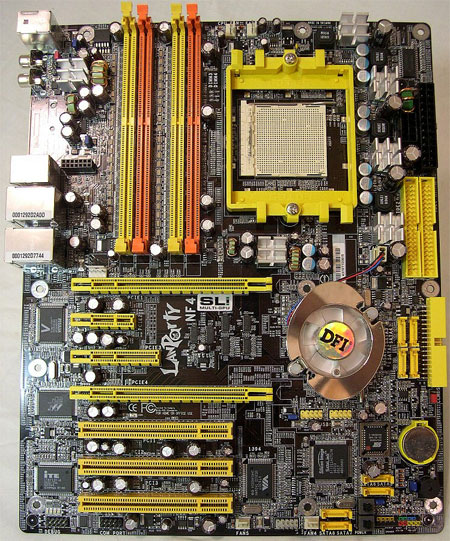
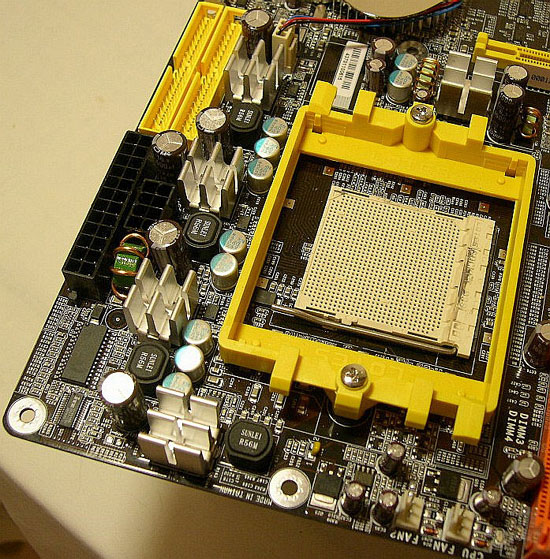
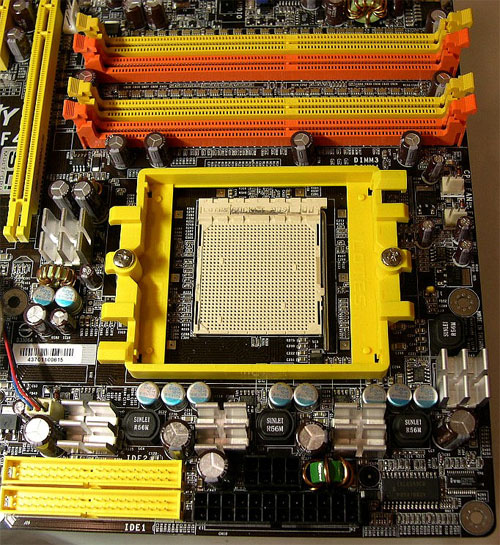
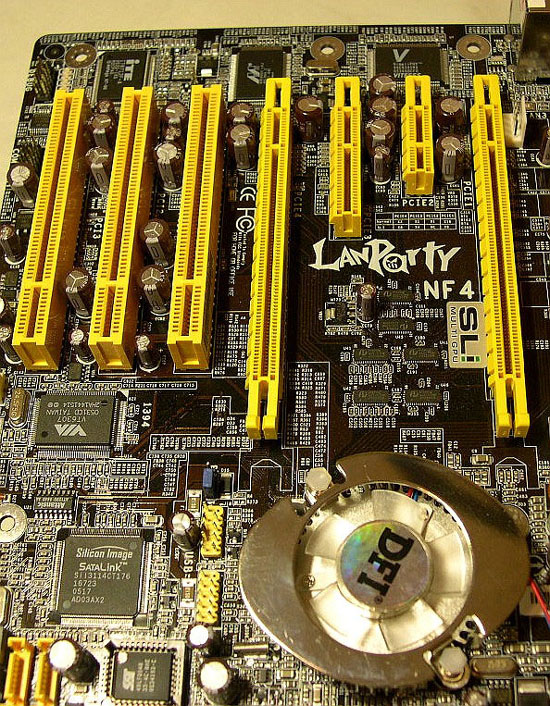
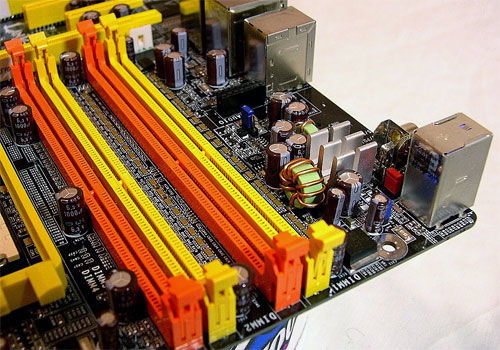








40 Comments
View All Comments
nvidia4ever1 - Friday, November 25, 2005 - link
Let's add the following-Watercooling on the standard overclocking results??? I can see it on the extreme overclocking results but how many people watercool their systems in general and why not show air cooling. All other AT reviews are based on air-cooling, why the change now.
The gaming and general performance charts just do not make sense without comparing apples to apples. The 3Dmark chart is most confusing. Why not show some real game benchmarks, who freaking plays aquamark and pcmark?
Workstation performance??? WTF??? It was nice to see the AMD system romp on the Intel systems but if this board is for the extreme overclocker why do they care about Maya results?
Why compare 7800GTX results to 6800u results with different drivers? WTF is going on with this kind of testing.
Even though the audio/disk/ethernet performance should be the same, why not test it and see if something is different just in case. Considering the additional audio information in the last AMd and Intel board reviews, why not have it here with real games. Who knows, the cpu utilization could be a lot lower than other ALC850s (like Abit)or higher like Gigabyte.
Any reason not to mention how many and what the results were? Did Corsair or others have input into the testing like OCZ did? What kind of memory should I buy for this board?
It was good to see the overclocking information and what can be done with a board but why not show some real results with it. Can I play BF2 or COD2 at 320HTT? Please follow up with some game benchmarks at both standard and overclocked settings.
Wesley Fink - Friday, November 25, 2005 - link
Randi's earlier review followed standard AnandTech motherboard testing, but we asked him on this review to go wherever he wanted in overclocking on this Expert board. We had already tested the original DFI nF4 SLI-DR, and the Expert was primarily an upgreade to provide even better overclocking performance and stability at high overclocked speeeds.This seemed the perfect board to approach from an extreme overclocker's perspective - and that's exactly what Randi did. We decided a lot of water-cooling users would be interested in this board, so Randi used watercooling in some of his tests. He also included base performance numbers so you can compare to other AT reviews.
We have limited our standard reviews to air cooled overclocking, since that is very widely used these days (often by users who don't have a clue what they're doing). However, Gary, myself, and in particular Randi are all long-term overclockers, and sometimes we like to share a little more about where you can go with some of the equipment we test.
Consider this an extreme overclocker's review of an updated board clearly aimed at the extreme overclocker.
RSica - Friday, November 25, 2005 - link
"Any reason not to mention how many and what the results were? Did Corsair or others have input into the testing like OCZ did? What kind of memory should I buy for this board?"All the memory tested in the review was listed or mentioned(BH-5 based Kingston KHX3500 + OCZ Platiminum LE PC3500). The Kingston and OCZ BH-5 did not perform well on this board though the Corsair 3200LL BH-5 did and was included.The main reason for their poor performance could be attributed their age(2+ years old) and the fact I've pushed 3.6v+ through them in overclocking endeavors in the past.
OCZ did NOT have input into my memory testing, but their Guru Tony Leach provided some insight into the boards revisions as conveyed to him by DFI.
All results were listed as per the tables provided to illustrate top memory clocks for each of the Memory module sets.
Again, thanks :)
Randi
RSica - Friday, November 25, 2005 - link
As explained in my previous reply, I arrived here to review bringing with me an extensive overclocking background.The addition of watercooling brings a new dimension to the testing and evaluation performed in my reviews for AnandTech. There are many more people watercooling these days and its safe to to say that it is becoming more mainstream than even a couple of years ago.Of course when running a CPU at stock speeds in a review there is no benefit(outside of lower CPU temperature), the benefit only coming when attaining a top CPU overclock.I also have several Phase Change coolers that someday may be used for the Top Overclock
section which could include Top Overclock on air, water and or Phase Change. Just a thought for now:)
As mentioned before, I did update the Gaming Performance charts and will update the others as time allows.
As far as Workstation performance, though this board is aimed at the Overclocking crowd, with it's full feature set it indeed can fulfill a Workstation role and does so admirably IMHO.
Again, thank you for your comments,
Randi
Griswold - Friday, November 25, 2005 - link
I love my Ultra-D but 2 things I cant stand:1. The name "Lanparty"
2. The ridiculous childish box
ceefka - Friday, November 25, 2005 - link
Yeah that kid doesn't seem to grow up with you ;-)Barbarossa - Friday, November 25, 2005 - link
I believe the Corsair CMX1024-4000PT modules use the Samsung UCCC modules, not the Samsung TCCD modules. This would explain why they do not work at 2-2-2-5 latency.Also, TCCD ICs do not come in 64x8 density, so it's impossible to make a 1GB TCCD module without somehow cramming 32 chips on there.
Live - Friday, November 25, 2005 - link
I beleive this is correct. If not this would be the worlds first 1gb stick with TCCD.Calin - Friday, November 25, 2005 - link
"With the SIL 3132 available, it would have made sense to include that SATAII controller, which would have given this board 8 SATAII channels and thus keeping this board future-proof and flexible."How is a board with eight SATA connectors more future-proof than one with only 4 SATA connectors? Would anyone have more than 4 disk devices (hard drive, optical drive)?
Anyway, there are other four SATA ports from the chipset, so if you think they are lower performance, use them for SATA optical devices (when they will appear), and use the four connectors from the Sil controller to drive four hard drives.
MarkHark - Friday, November 25, 2005 - link
More important than the number of available ports is features. What about NCQ support? Is the current controller fully SATA-II compatible?